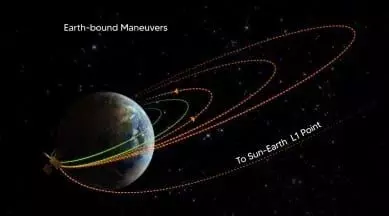
Second earth-bound manoeuvre completed by Aditya L1: ISRO
text_fieldsBengaluru: The second earth-bound manoeuvre for Aditya L1, the first Indian mission to orbit and study the Sun, was successfully completed early on Tuesday, according to ISRO.
The operation was run by the Telemetry, Tracking and Command Network (ISTRAC) of ISRO.
"The second Earth-bound manoeuvre (EBN#2) is performed successfully from ISTRAC, Bengaluru. ISTRAC/ISRO's ground stations at Mauritius, Bengaluru and Port Blair tracked the satellite during this operation. The new orbit attained is 282 km x 40225 km," ISRO said in a post on X (formerly Twitter).
The next manoeuvre (EBN#3) is scheduled for September 10, 2023, around 02:30 Hrs. IST, it said.
Aditya-L1 is the first Indian space-based observatory to study the Sun from a halo orbit around the first Sun-earth Lagrangian point (L1), which is located roughly 1.5 million km from Earth.
The first earth-bound manoeuvre was successfully performed on September 3.
The spacecraft will undergo two more earth-bound orbital manoeuvres before being placed in the transfer orbit towards the Lagrange point L1. Aditya-L1 is expected to arrive at the intended orbit at the L1 point after about 127 days.
ISRO's Polar Satellite Launch Vehicle (PSLV-C57) on September 2 had successfully launched the Aditya-L1 spacecraft, from the Second Launch Pad of Satish Dhawan Space Centre (SDSC), Sriharikota.
After a flight duration of 63 minutes and 20 seconds, the Aditya-L1 spacecraft was successfully injected into an elliptical orbit of 235x19500 km around the Earth.
According to ISRO, a satellite placed in the halo orbit around the L1 point has the major advantage of continuously viewing the Sun without any occultation /eclipses. This will provide a greater advantage in observing solar activities and their effect on space weather in real-time.
Aditya-L1 carries seven scientific payloads indigenously developed by ISRO and national research laboratories including the Indian Institute of Astrophysics (IIA), Bengaluru, and Inter-University Centre for Astronomy and Astrophysics (IUCAA), Pune.
The payloads are to observe the photosphere, chromosphere and the outermost layers of the Sun (the corona) using electromagnetic and particle and magnetic field detectors.
Using the special vantage point L1, four payloads directly view the Sun and the remaining three payloads carry out in-situ studies of particles and fields at the Lagrange point L1, thus providing important scientific studies of the propagatory effect of solar dynamics in the interplanetary medium.
The suits of Aditya L1 payloads are expected to provide the most crucial information to understand the problem of coronal heating, coronal mass ejection, pre-flare and flare activities and their characteristics, dynamics of space weather, and propagation of particles and fields.
According to scientists, there are five Lagrangian points (or parking areas) between the Earth and the Sun where a small object tends to stay if put there. The Lagrange Points are named after Italian-French mathematician Joseph-Louis Lagrange for his prize-winning paper -- "Essai sur le Problème des Trois Corps, 1772." These points in space can be used by spacecraft to remain there with reduced fuel consumption.
At a Lagrange point, the gravitational pull of the two large bodies (the Sun and the Earth) equals the necessary centripetal force required for a small object to move with them.
With PTI inputs
























